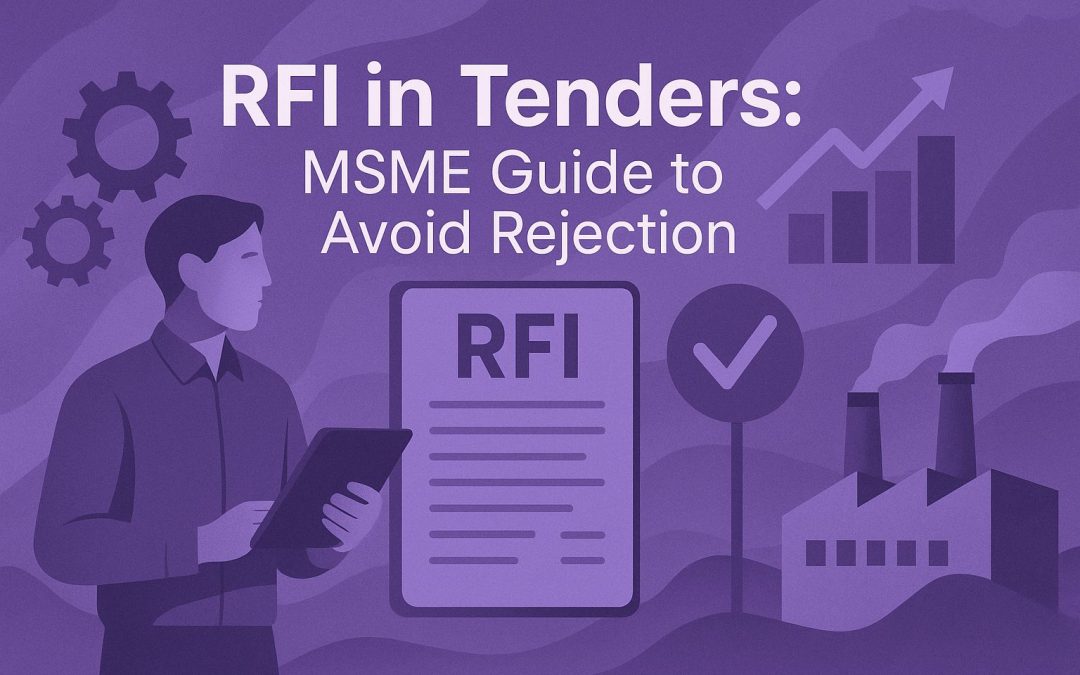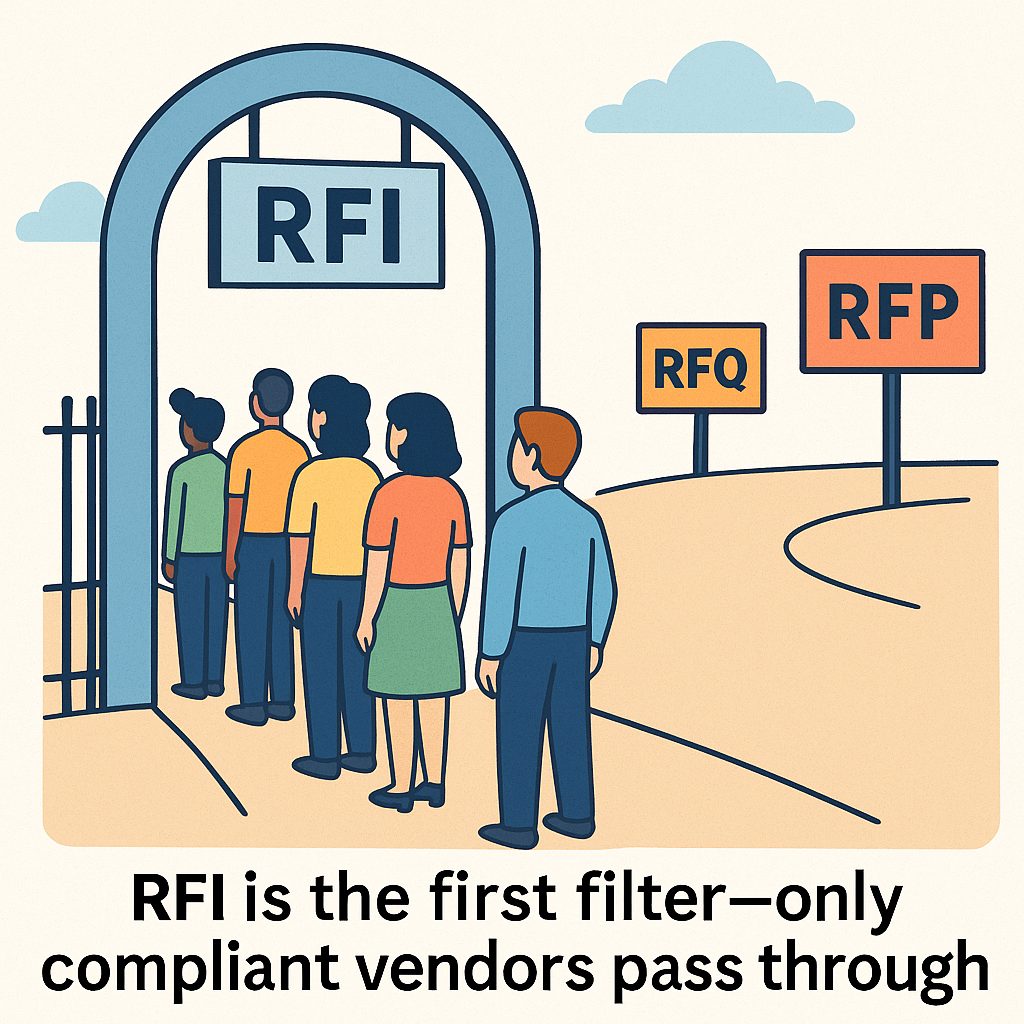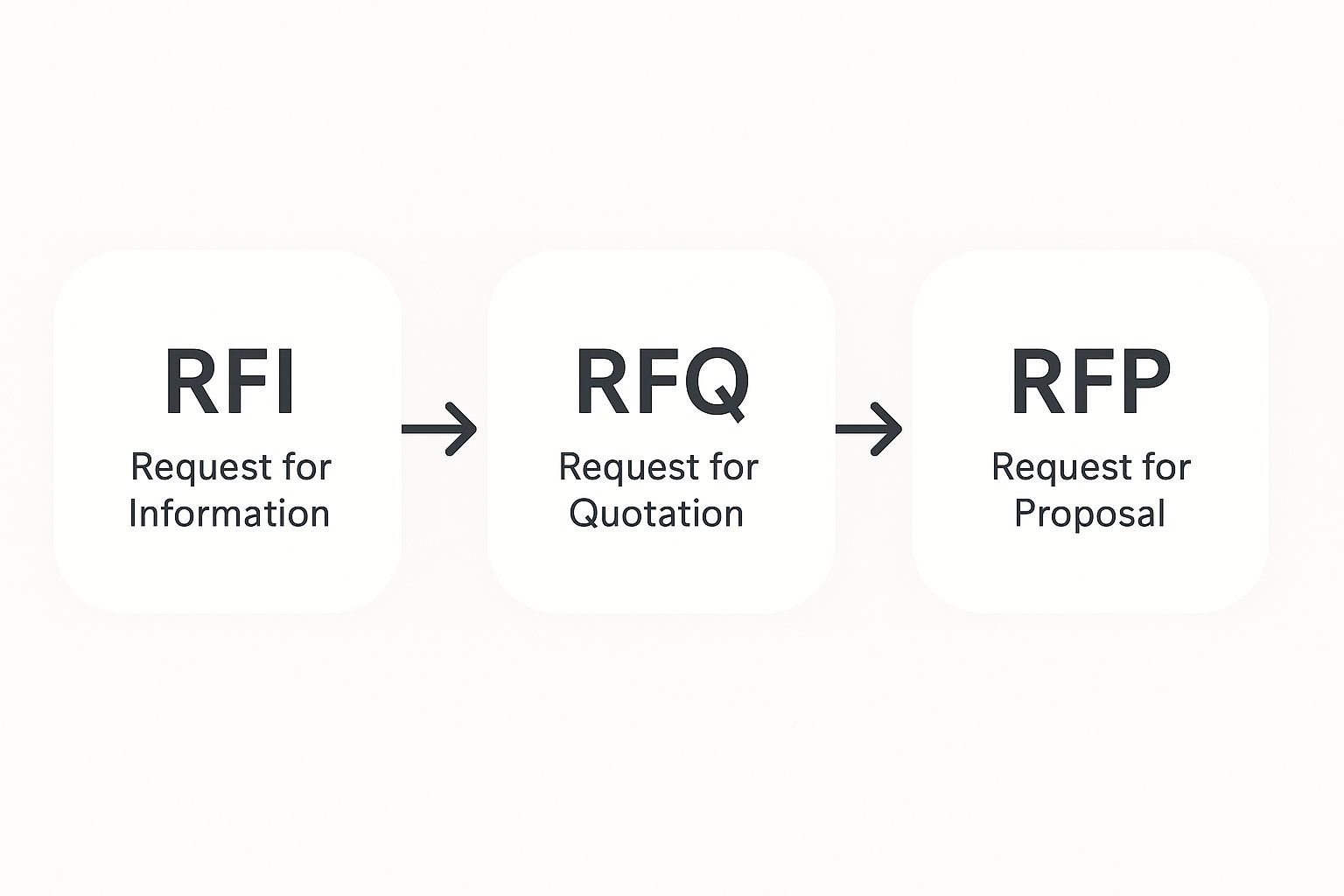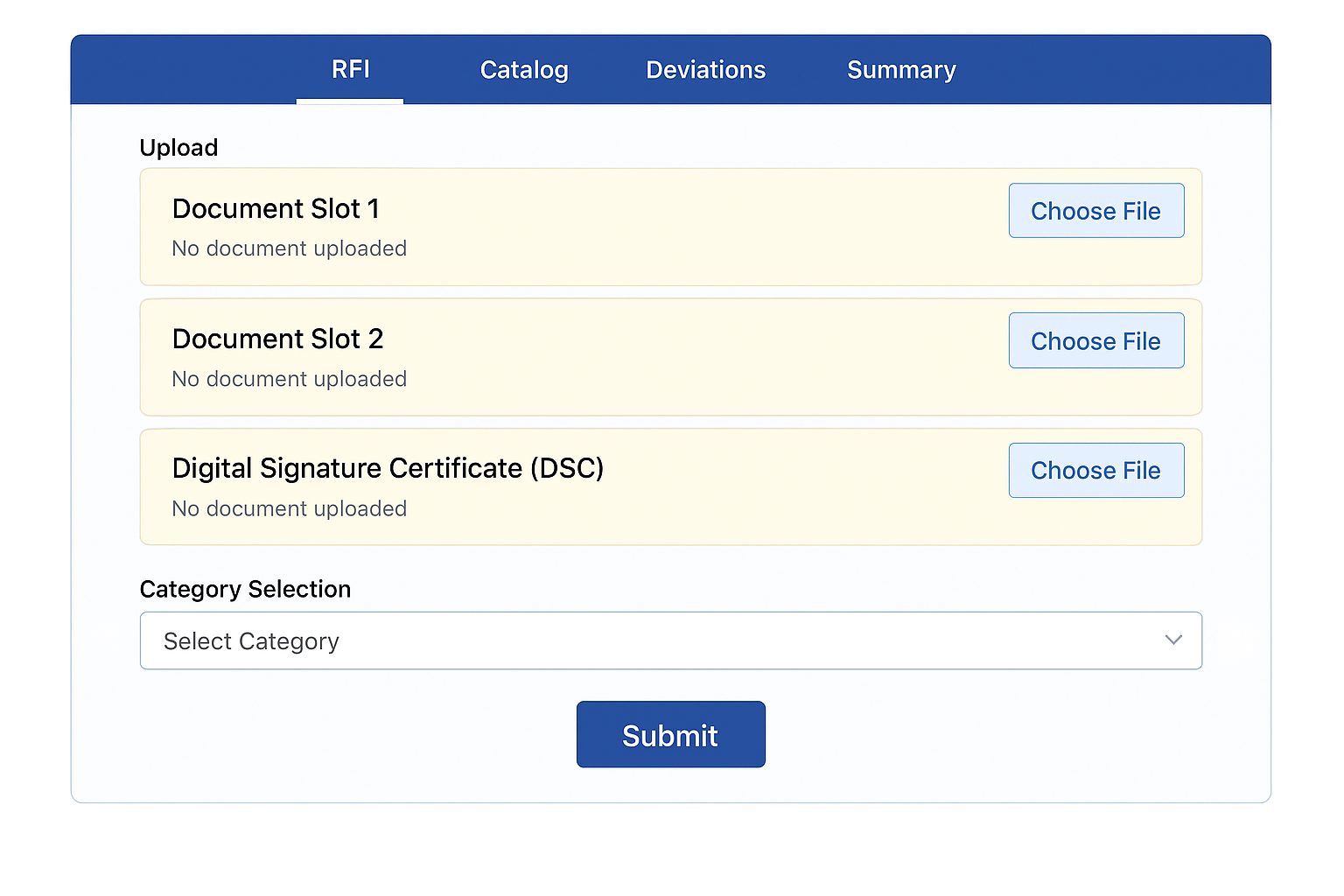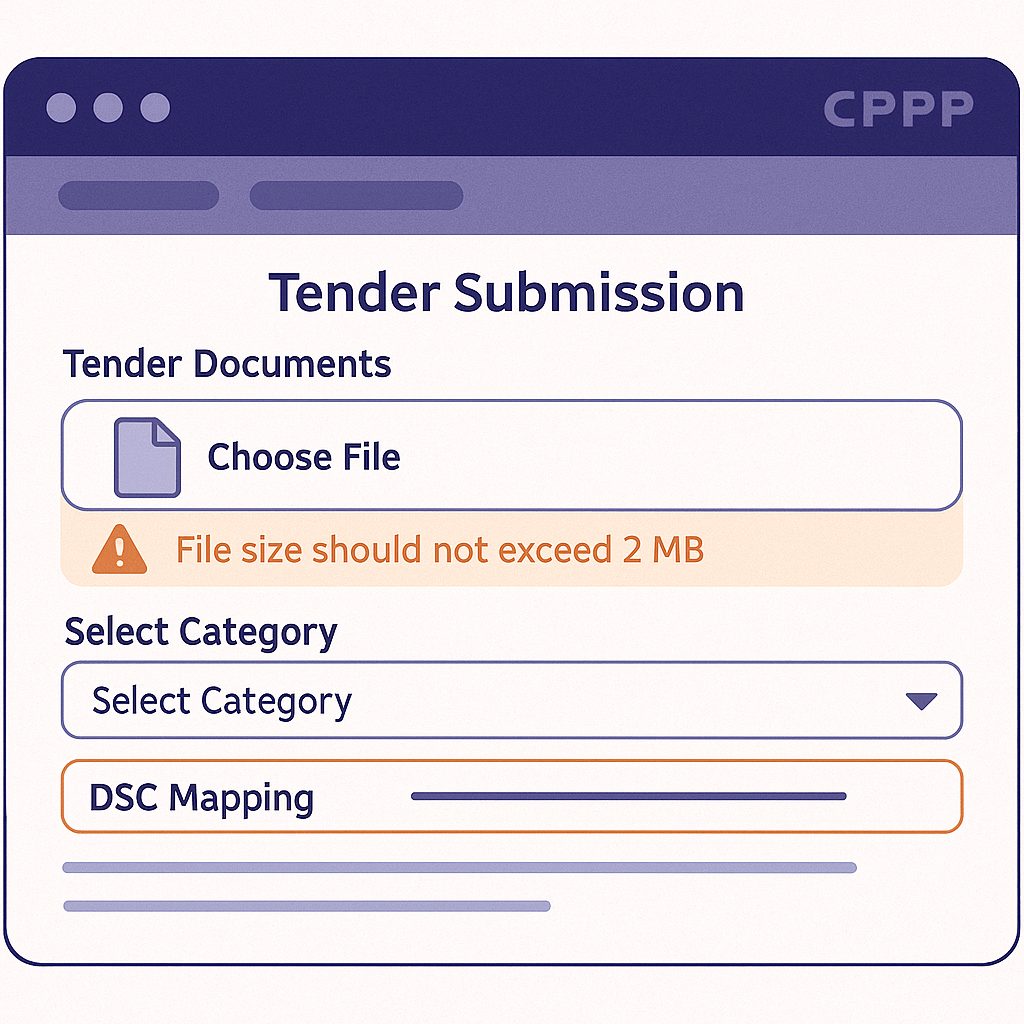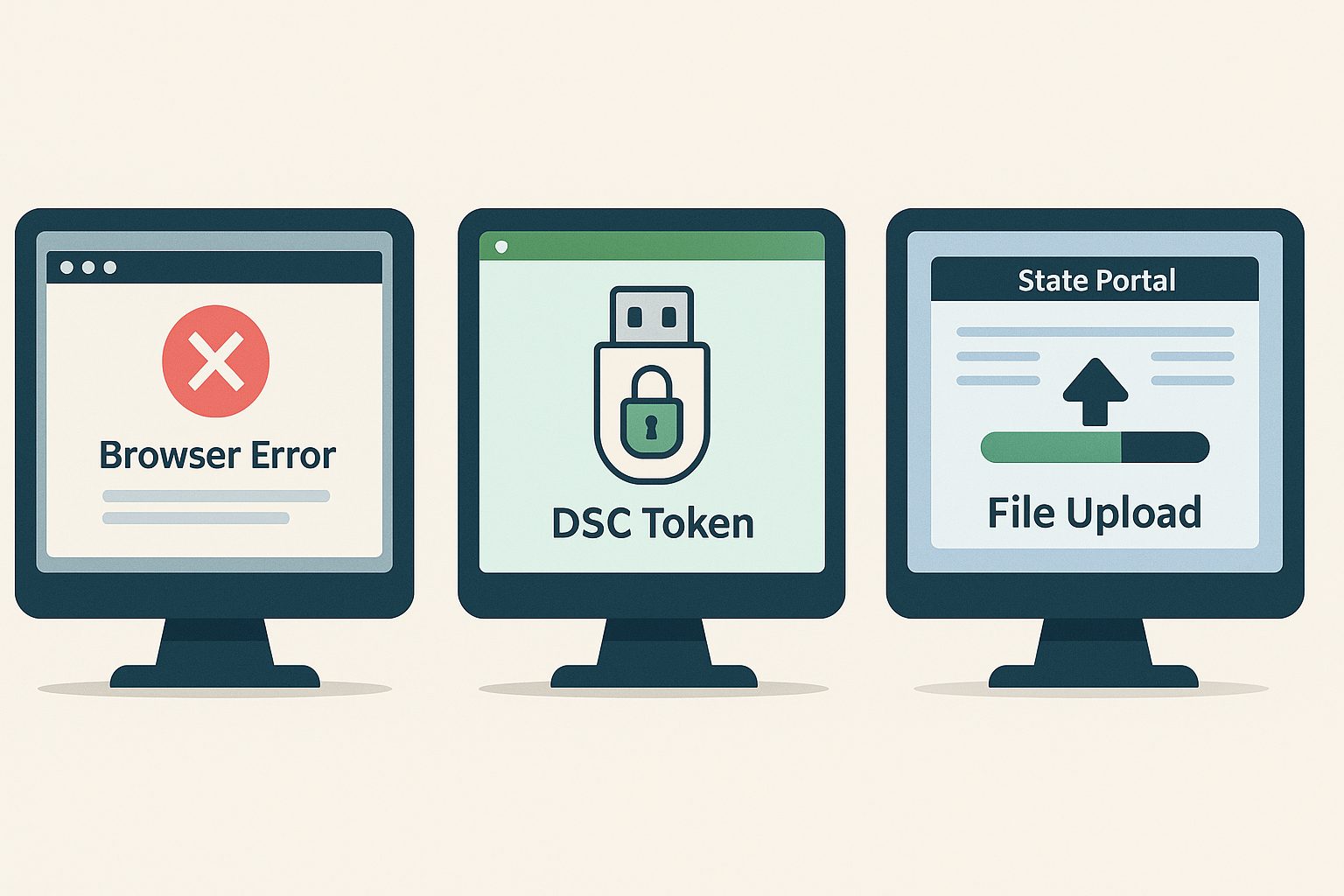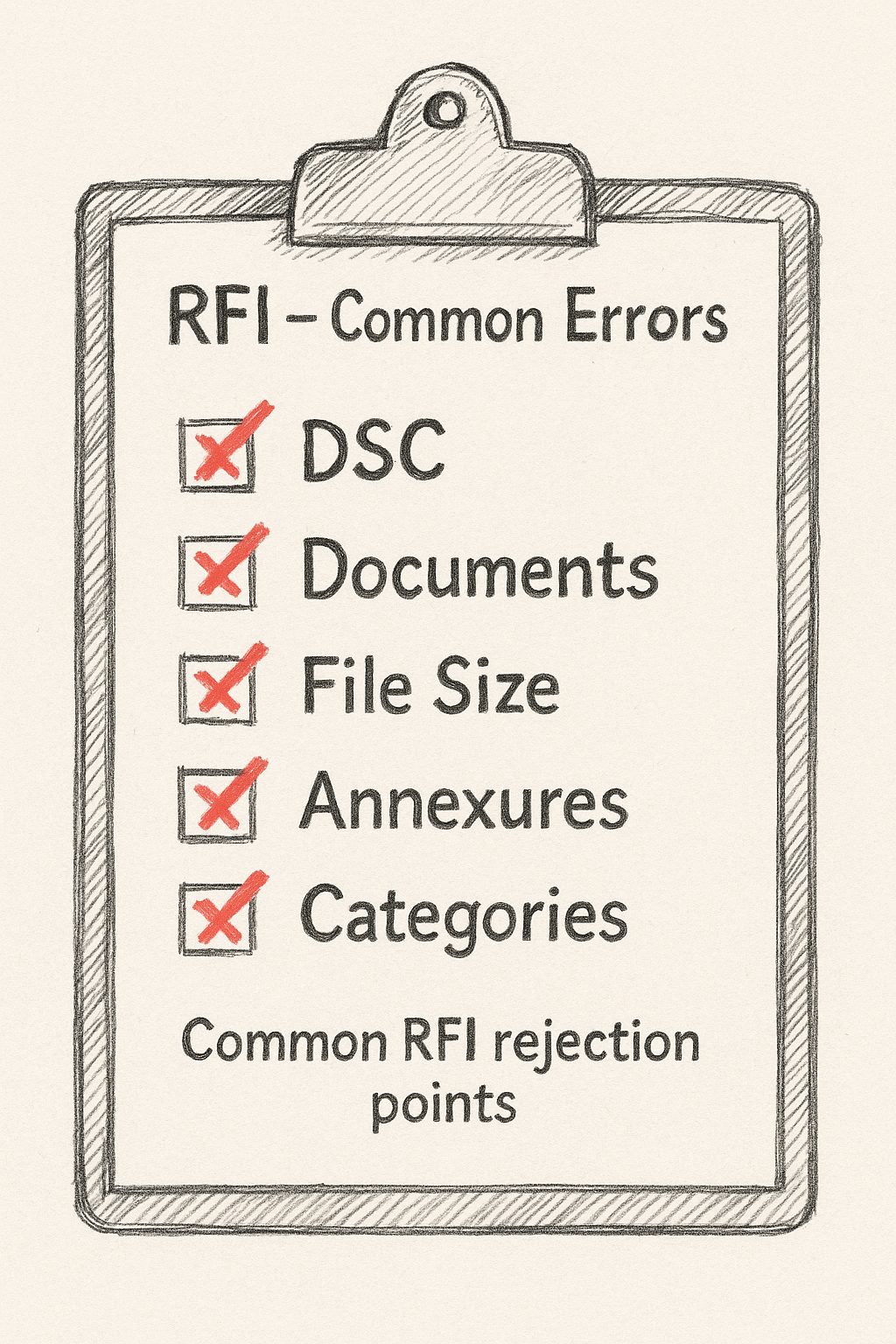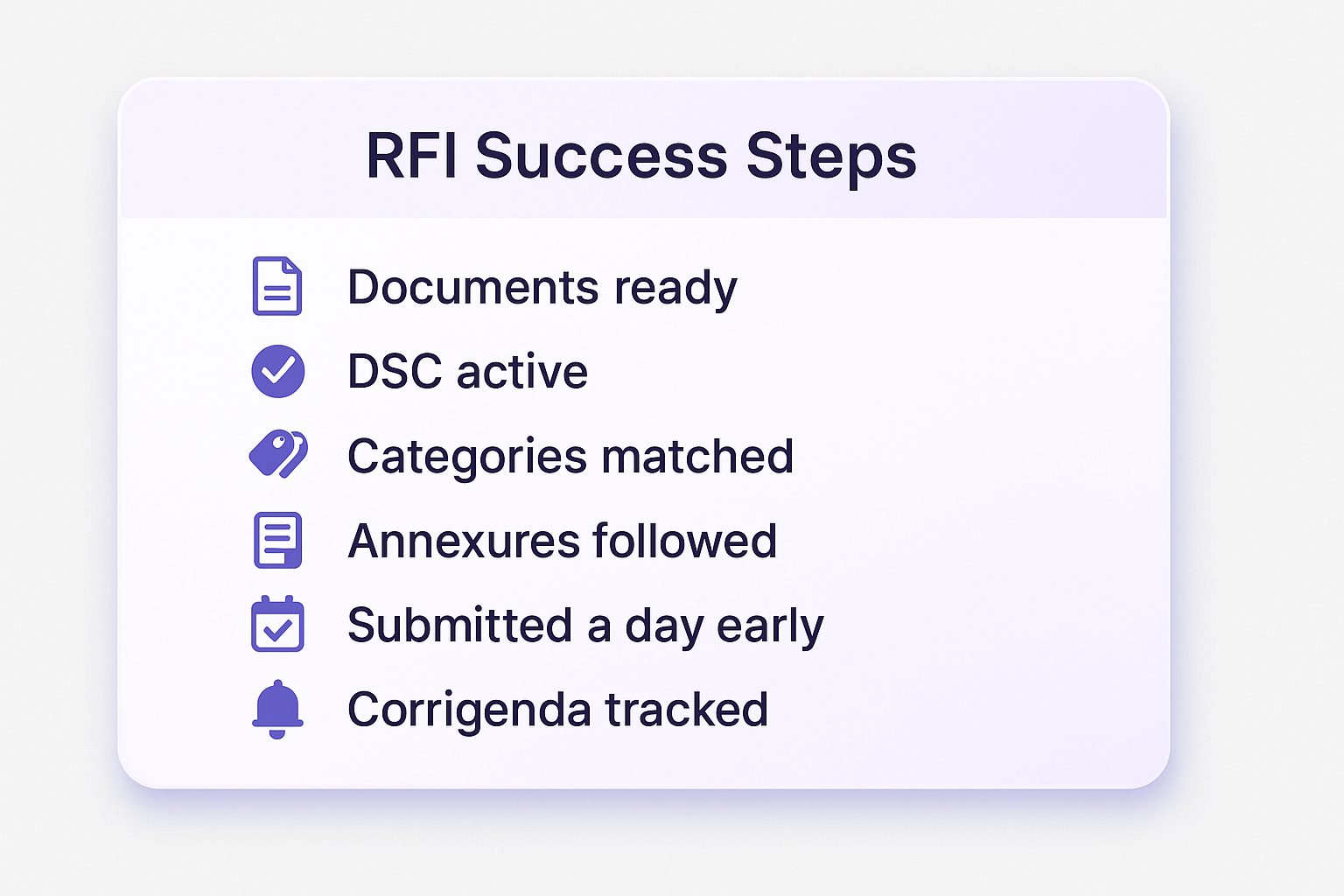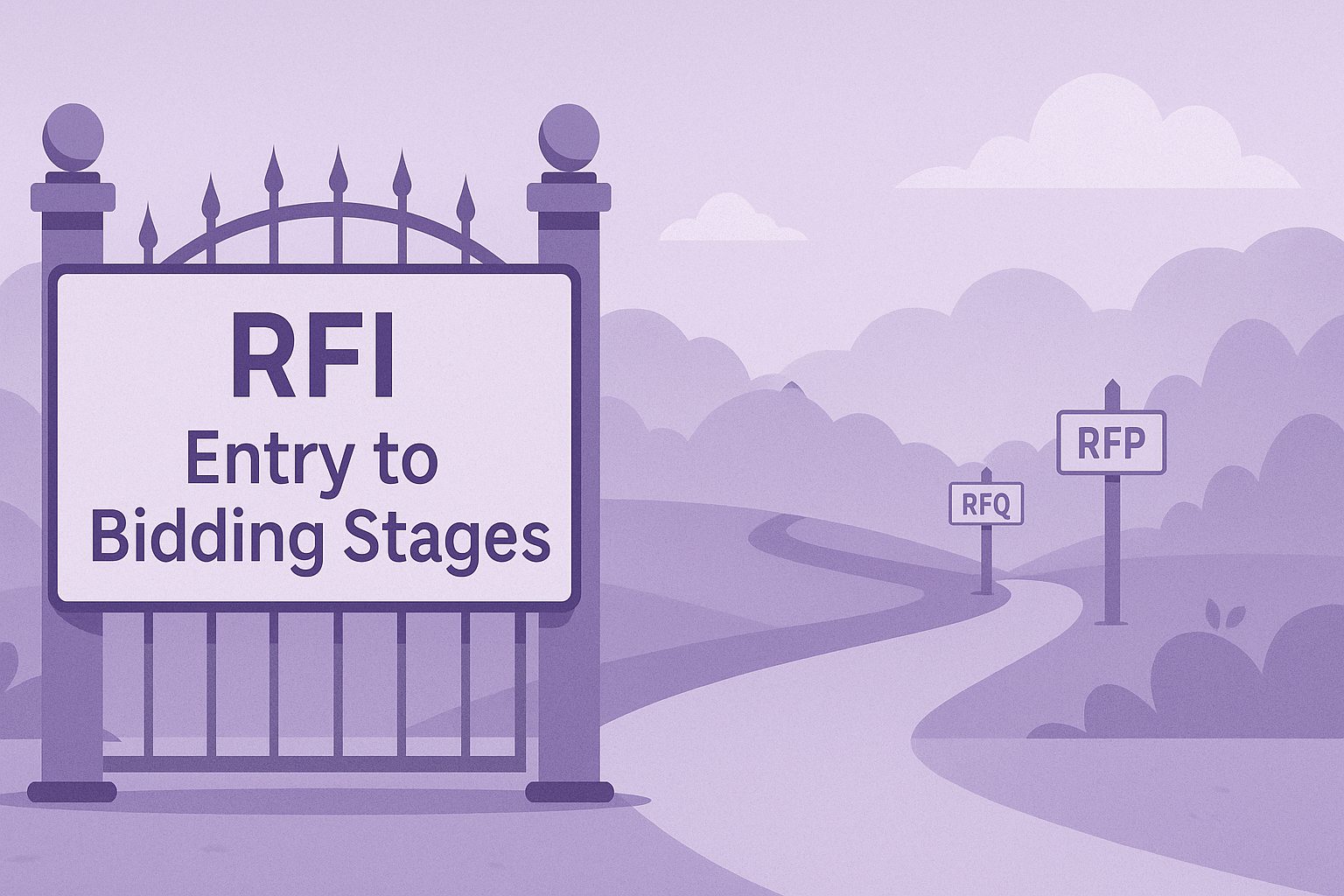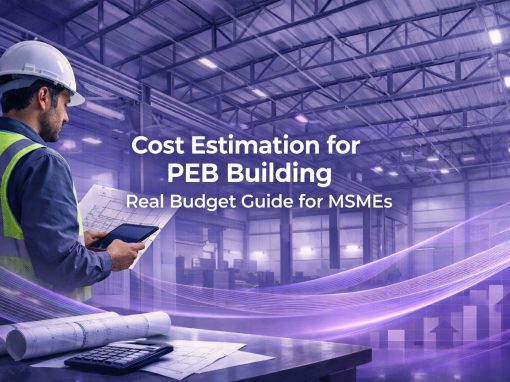Table of Contents
Public procurement does not begin with pricing. It begins with trust. The Request for Information (RFI) is often the very first step, and it sets the tone for everything that follows. Buyers use it to check whether a vendor has the minimum capability, the right paperwork, and a clear profile before moving to the serious evaluation stages.
For many MSMEs, this stage is misunderstood. Some treat it like a casual form, copy-paste a response, or upload incomplete certificates. Later they discover that the tender portal has already marked them non-compliant. It could be something as small as a GST number not matching PAN details, a digital signature certificate that expired last week, or a missing MSME registration upload. None of these are major faults in the business, but in the eyes of the system they are grounds for instant rejection.
The RFI is not about winning a contract. It is about clearing the first filter. Government departments want to know who is capable, who is eligible, and who can be taken seriously for the next round. For a small business, getting this part right is the difference between progressing to an RFQ or RFP and being shut out before the real bidding even begins.
This guide unpacks the RFI meaning in tenders, explains how it differs from RFQ and RFP, and gives step-by-step clarity on platforms like GeM, CPPP, and state e-tender portals. It also points out the most common mistakes MSMEs make and how to avoid them. The goal is simple: help small vendors respond correctly the first time, so their bids are not lost to preventable errors.
What is RFI in Tenders?
Every tender cycle has a first doorway. That doorway is called the Request for Information (RFI). It is not about quoting rates or submitting full technical proposals. It is about proving that your business exists, is compliant, and is worth inviting to the next round.
Buyers release RFIs to map the market. They want to see how many suppliers are out there, what kind of capacity exists, and whether MSMEs can actually deliver. If the RFI responses look weak, the tendering authority sometimes even rewrites the scope before launching the real bid.
Many small businesses mistake the RFI for an RFQ or RFP. The difference is simple. RFQ (Request for Quotation) is about price. RFP (Request for Proposal) is about solutions and technical details. The RFI is about identity and capability. Miss that point and you’re out before the race begins.
This is also where most rejections happen quietly. A food processing unit in Pune lost its chance because the uploaded GST certificate showed an old trade name. A small IT firm in Noida never cleared the stage because their digital signature certificate expired two days earlier. These are not dramatic failures, but they are enough to block entry.
For MSMEs, the RFI should be treated as a credibility test. A clean response means: correct tender RFI format, updated MSME certificate, valid DSC, and documents that match across GST, PAN, and Udyam details. Get this right and the doors to RFQ and RFP open smoothly. Get it wrong and the portal moves on without you.
How MSMEs Can Respond to RFI on GeM
The Government e-Marketplace (GeM) has become the main entry point for central procurement. For small vendors, the RFI here feels like a simple online form. In practice, it is a gatekeeper. A single overlooked detail can keep a business invisible to buyers.
Registration is the first step: Aadhaar, PAN, GST, and a seller profile. Many stop here, thinking they are ready to respond. They are not. Unless the product and service categories are filled with precision, the system quietly excludes the vendor. No alert, no explanation—just no access to the RFI notice.
The digital signature certificate (DSC) is where most vendors stumble. GeM requires a valid Class III DSC, and it is sensitive to browser settings. If the certificate expired yesterday or the driver isn’t installed properly, the upload will fail. One MSME in Surat learned this the hard way when Chrome refused to detect their DSC. By the time they tried Internet Explorer, the deadline had already passed.
Even small missteps in category mapping create silent rejection. A supplier registered under “General Welding” will never show up if the RFI sits under “Custom Metal Components.” The mismatch locks them out without any message explaining why.
Basic Checklist to Keep In Mind
For a smooth response, MSMEs should run through a basic checklist before hitting submit:
- Test the DSC on the right browser and renew it early.
- Upload current GST and PAN records along with your Udyam certificate and bank details to avoid rejection.
- Match categories exactly with the RFI notice.
- Compress PDFs within the file size cap; oversized files disappear without warning.
The RFI stage on GeM is not about winning a contract. It is about proving discipline—showing that a vendor can follow rules and present a clean profile. Those who do it right move forward. Those who slip vanish from the process without ever being told why.
How MSMEs Can Respond to RFI on CPPP
The Central Public Procurement Portal (CPPP) is older than GeM, and it shows. The interface is clunky, but thousands of ministries and PSUs still use it. For MSMEs, the RFI stage here is not difficult—it is unforgiving.
DSC
The first roadblock is the digital signature certificate (DSC). CPPP accepts only correctly mapped tokens. If the DSC is linked to the wrong director, or if the driver is out of date, the portal shuts you out. A construction supplier in Nagpur had a valid Class III DSC that worked fine on GeM. On CPPP, it failed because the PAN holder’s name did not match the company’s registered entry.
File Uploads
File uploads create another headache. CPPP sets tight caps, often 2 MB per file. Vendors who scan annexures at high resolution run into silent rejections. The portal will not scale the document—it simply refuses the file. One electrical MSME in Bhopal spent hours compressing PDFs down to size, only to realise the system also rejected the newer PDF version they used.
Annexure Formats
Then there are the annexure formats. Departments upload sample templates for declarations, turnover, and experience details. If an MSME uploads the right information but in a different format, it still gets marked “non-responsive.” The authority rarely explains why—it just records a rejection.
What works on CPPP is discipline:
- Renew and map the DSC to the authorised signatory before logging in.
- Scan and compress files well within the limit; avoid last-minute edits.
- Use the exact annexure templates issued with the notice.
- Check every mandatory field, even if it looks repetitive.
On this portal, an RFI is not about creativity. It is about proving you can follow instructions line by line. MSMEs that prepare carefully clear the stage. Those that improvise find themselves excluded without a reason.
State eTender Portals: What MSMEs Should Know
Every state runs its own eTender portal, and none of them look the same. Some use upgraded interfaces, others still rely on outdated Java plug-ins. For MSMEs, the RFI process here is rarely about what you can supply. It is about whether you can even make the system work on your computer.
Browser Dependency
The first issue is browser dependency. Several state portals still function only on Internet Explorer or demand a specific Java version. A machinery supplier in Jaipur found that the Rajasthan portal would not open on Chrome. They had to switch to an older setup just to upload a simple RFI response. By then, half a day was wasted.
Document Rule Changes
The second problem is document rules that change by department. One state might require a turnover certificate from a chartered accountant. Another might accept a self-declaration. If an MSME assumes the rules are uniform, the portal marks their response incomplete. The tender authority rarely allows corrections once the deadline closes.
Connectivity
Connectivity adds another layer of trouble. Portals in smaller states or municipal bodies often slow down near deadlines. A contractor in Guwahati described the Assam portal freezing repeatedly during the final upload hour. The documents were correct, but the system never confirmed submission. In procurement terms, that counts as “not submitted.”
To handle state-level RFIs, MSMEs should build habits:
- Check which browser and plug-ins the portal requires—install them early.
- Read the specific department’s annexure instructions line by line.
- Upload documents a day before the deadline to avoid server crashes.
- Keep local certificates ready—some states ask for labour registration, trade licenses, or state tax clearances.
Unlike GeM or CPPP, these portals do not forgive mistakes. Each one plays by its own rulebook. Vendors who adapt quickly move forward. Those who expect a standard process lose time and bids.
Common Errors that Lead to RFI Rejection
Most MSMEs get filtered out of RFIs for small mistakes. Not capability issues. Not pricing. Just details that trip the system.
Expired or Wrong DSC
- Certificates often sit expired for weeks without notice.
- Some are mapped to the wrong director or signatory.
- CPPP is especially strict: if the PAN name on the DSC doesn’t match the company record, upload fails.
A contractor in Nagpur lost an RFI this way. The DSC worked on GeM, but CPPP refused it.
Documents That Don’t Match
- GST certificate shows an old trade name.
- Udyam certificate missing or outdated.
- Turnover proof not signed by a CA.
A Tirupur textile MSME lost eligibility because their CA forgot to sign the balance sheet. Everything else was correct.
File Upload Failures
- CPPP blocks files above 2 MB.
- Some portals only accept older PDF versions.
- Oversized files don’t show an error; they just don’t attach.
An IT vendor in Bhopal thought their upload was done. The buyer never saw it.
Annexure Mistakes
- Departments share fixed templates.
- Vendors who improvise their own format are marked non-responsive.
- No explanation is given — the system just rejects.
Wrong Category Selection
- GeM filters strictly by product category.
- Vendors who tick “General” miss specific RFIs.
- The portal does not send an alert; the RFI simply never appears.
Quick Survival Notes
- Renew DSCs early. Test them on the right browser.
- Keep GST, PAN, and Udyam details aligned.
- Compress and check file versions before upload.
- Never ignore the annexure format supplied.
- Map your product to the closest exact category.
These are not hard fixes. But MSMEs who skip them often realise only when the RFI window closes, and by then the system has already moved on.
Tips to Improve RFI Success for MSMEs
Most MSMEs lose RFIs not because of capability but because of preventable errors. The ones that prepare a system for themselves move through cleanly. The ones that scramble at the last hour usually get cut off.
Keep a Tender File Ready
Every business should maintain a folder with GST, PAN, Udyam certificate, and bank details. Updated, scanned, and compressed. A Delhi-based furniture MSME kept a master file like this—every RFI upload took minutes instead of hours.
Do Not Wait on DSC
Check the expiry date well in advance. Renew before the last month. Install drivers across browsers, even the outdated ones. GeM may run on Chrome, but CPPP still demands Internet Explorer. Vendors who tested late lost bids because their DSC failed mid-upload.
Match the Right Category
Wrong categories make you invisible. If the RFI is under “Electrical Maintenance” and you’ve ticked “General Services,” you are out. Recheck your GeM profile after edits; sometimes categories reset without notice.
Follow Annexures Exactly
Departments issue templates for a reason. Change the layout or headings and the system marks you “non-responsive.” A small IT vendor in Hyderabad copied the annexure into Word, altered formatting, and got rejected despite correct data.
Submit Early
State portals freeze close to deadlines. Servers crash, uploads hang. Submitting one day early is not overcaution—it is survival. Assam’s portal is known for choking in the last hour; plenty of contractors learned this the hard way.
Track Corrigenda
Many buyers upload corrigenda after an RFI goes live. Sometimes it’s a new date, sometimes a revised annexure. If you miss it, your old submission becomes invalid. Check portals daily or set alerts; do not assume the first notice is final.
Why This Matters
The RFI is not about winning. It is about proving you can follow the rules. Those who prepare once—documents in order, DSC tested, categories matched—rarely face rejection. Those who take it casually often find their names missing when the RFQ stage begins.
Conclusion
The RFI stage is where most MSMEs lose ground. Not because they lack capacity, but because the basics are ignored. An expired DSC, a wrong annexure, or a category mismatch is all it takes for the system to move past you.
Treat the RFI as a filter. Those who prepare once—documents current, DSC tested, formats followed—sail through quietly. Those who wait until the last day or improvise get rejected without even knowing why.
Success in public procurement is built step by step. The RFI is the first one. Get it right, and the road to RFQ and RFP opens. Get it wrong, and the process ends before it even begins.
Looking for the right government tenders for your business?
Tata nexarc helps MSMEs, manufacturers, and service providers find relevant government tenders across India. Discover tenders by location, category, or department, track deadlines, and get notified on time — with complete support to help you apply confidently.
FAQs
Does an RFI require EMD or bid security?
Can I skip GST or PAN if my firm is newly incorporated?
Are scanned e-signs acceptable or is DSC mandatory at RFI?
What if I missed the RFI but want to bid in the RFQ?
Can I protect proprietary info in an RFI response?
Do consortiums or subcontractors qualify at RFI?
Which language should documents be in?
How do I show past performance if my firm is new?
What time does the portal use for the RFI deadline?
Can staff users submit on behalf of the proprietor or director?
Ananya Mittal blends a background in data science with a passion for writing, contributing to Tata Nexarc’s efforts in creating insightful, data-informed content for MSMEs. Her work focuses on exploring sector-specific challenges and opportunities across procurement, logistics, and business strategy. She is also involved in leveraging analytics to strengthen content performance and deliver actionable insights to India's growing B2B ecosystem.
